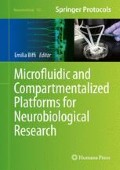Abstract
Studying the formation and function of neuronal circuitry is complicated by the heterogeneity and high density of neuronal processes and synapses. Compartmentalized cell culture systems offer a simple yet powerful solution for isolation of axons from dendrites and cell somas. This chapter describes how to manufacture and use a microfluidic chip with a modular design for highly defined isolation of axons, asymmetric genetic manipulation, and whole-cell patch clamp recording. The microfluidic chip consists of detachable and resealable layers that allow multiple modes of operation during cell culture, fluidic isolation for limited transfection, and recording with low-angle electrode access. This versatile technique is useful for functional studies that require specific expression of for example optogenetic tools in presynaptic neurons or for studying the entry of pathogenic particles, such as viruses or oligomers of misfolded proteins, into presynaptic structures.
Access this chapter
Tax calculation will be finalised at checkout
Purchases are for personal use only
References
Wu HI, Cheng GH, Wong YY, Lin CM, Fang W, Chow WY, Chang YC (2010) A lab-on-a-chip platform for studying subcellular functional proteome of neuronal axons. Lab Chip 11:647–653
Taylor AM, Berchtold NC, Perreau VM, Tu CH, Li JN, Cotman CW (2009) Axonal mRNA in uninjured and regenerating cortical mammalian axons. J Neurosci 11:4697–4707
Campenot RB (1977) Local control of neurite development by nerve growth factor. Proc Natl Acad Sci U S A 11:4516–4519
Taylor AM, Blurton-Jones M, Rhee SW, Cribbs DH, Cotman CW, Jeon NL (2005) A microfluidic culture platform for CNS axonal injury, regeneration and transport. Nat Methods 11:599–605
Sutton MA, Taylor AM, Ito HT, Pham A, Schuman EM (2007) Postsynaptic decoding of neuronal activity: eEF2 as a biochemical sensor coupling miniature synaptic transmission to local protein synthesis. Neuron 11:648–661
Osakada Y, Cui B (2011) Real-time visualization of axonal transport in neurons. Methods Mol Biol 11:231–243
Harrington AW, Ginty DD (2013) Long-distance retrograde neurotrophic factor signalling neurons. Nat Rev Neurosci 11:177–187
Ionescu-Zanetti C, Shaw RM, Seo J, Jan YN, Lee LP (2005) Mammalian electrophysiology on a microfluidic platform. Proc Natl Acad Sci U S A 11:9112–9117
Martina M, Luk C, Py C, Martinez D, Comas T, Monette R, Denhoff M, Syed N, Mealing GA (2011) Recordings of cultured neurons and synaptic activity using patch-clamp chips. J Neural Eng 11:034002
Jokinen V, Sakha P, Suvanto P, Rivera C, Franssila S, Lauri SE, Huttunen HJ (2013) A microfluidic chip for axonal isolation and electrophysiological measurements. J Neurosci Methods 212:276–282
Resto PJ, Morgen BJ, Berthier E, Williams JC (2010) An automated microfroplet passive pumping platform for high-speed and packeted microfluidic flow application. Lab Chip 10:23–26
Taylor AM, Rhee SW, Tu CH, Cribbs DH, Cotman CW, Jeon NL (2003) Microfluidic multicompartment device for neuroscience research. Langmuir 19:1551–1556
Nagel G, Brauner M, Liewald JF, Adeishvili N, Bamberg E, Gottschalk A (2005) Light activation of channelrhodopsin-2 in excitable cells of Caenorhabditis elegans triggers rapid behavioral responses. Curr Biol 15:2279–2284
Buchhalter JR, Dichter MA (1991) Electrophysiological comparison of pyramidal and stellate nonpyramidal neurons in dissociated cell culture of rat hippocampus. Brain Res Bull 26(3):333–338
Mynlieff M (1999) Identification of different putative neuronal subtypes in cultures of the superior region of the hippocampus using electrophysiological parameters. Neuroscience 93(2):479–486
Segal M (1983) Rat hippocampal neurons in culture: responses to electrical and chemical stimuli. J Neurophysiol 50(6):1249–1264
Yang J, Thio LL, Clifford DB, Zorumski CF (1993) Electrophysiological properties of identified postnatal rat hippocampal pyramidal neurons in primary culture. Brain Res Dev Brain Res 71(1):19–26
Carlborg CF, Haraldsson T, Cornaglia M, Stemme G (2010) High-yield process for 3-D large-scale integrated microfluidic networks in PDMS. J Microelectromech Syst 19:1050–1057
Lee JN, Park C, Whitesides GM (2003) Solvent compatibility of poly(dimethylsiloxane)-based microfluidic devices. Anal Chem 75:6544–6554
Acknowledgements
This research was supported by the Academy of Finland (grant #253223 and grant #266820).
Author information
Authors and Affiliations
Corresponding author
Editor information
Editors and Affiliations
Rights and permissions
Copyright information
© 2015 Springer Science+Business Media New York
About this protocol
Cite this protocol
Sakha, P., Brunello, C., Heikkinen, J., Jokinen, V., Huttunen, H.J. (2015). Asymmetric Genetic Manipulation and Patch Clamp Recording of Neurons in a Microfluidic Chip. In: Biffi, E. (eds) Microfluidic and Compartmentalized Platforms for Neurobiological Research. Neuromethods, vol 103. Humana Press, New York, NY. https://doi.org/10.1007/978-1-4939-2510-0_4
Download citation
DOI: https://doi.org/10.1007/978-1-4939-2510-0_4
Published:
Publisher Name: Humana Press, New York, NY
Print ISBN: 978-1-4939-2509-4
Online ISBN: 978-1-4939-2510-0
eBook Packages: Springer Protocols

